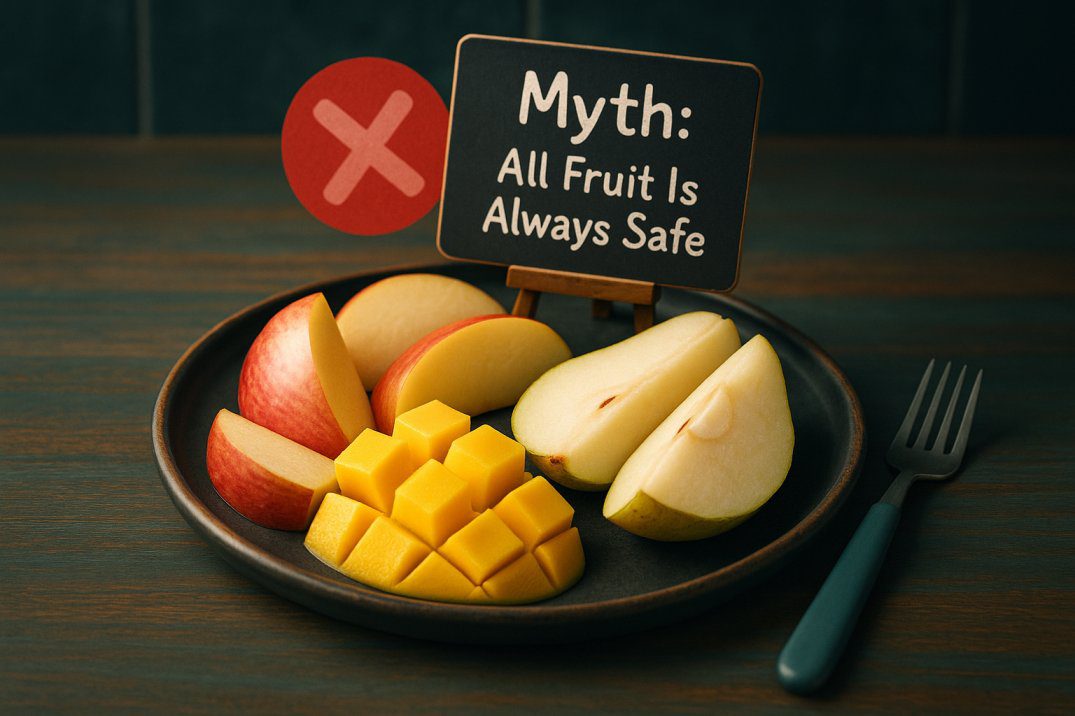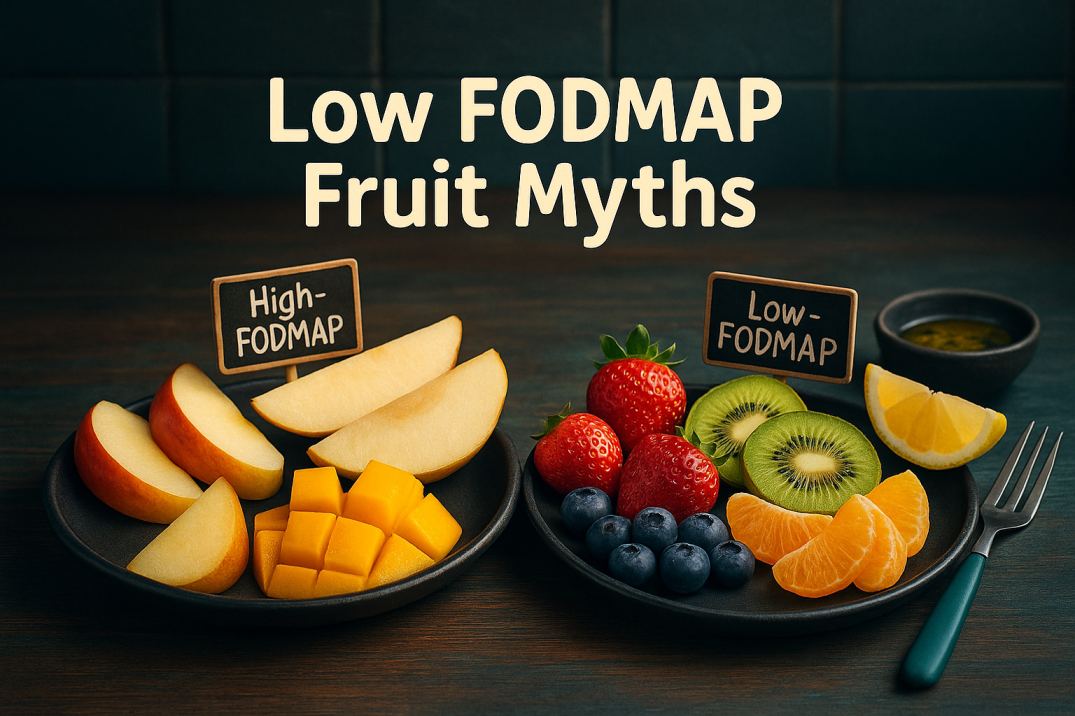Low FODMAP fruit myths can mislead even the savviest IBS managers. You might think “all fruit is safe,” but certain varieties and serving sizes can trigger symptoms. In this post, you’ll discover which fruits to limit, why some cause discomfort, and the best low-FODMAP options to enjoy without worry.
Table of Contents

1. Myth: All Fruit Is Always Safe
You’ve heard it before: fruit equals health. That idea underpins many low FODMAP fruit myths. Fruits like apples or pears pack high fructose or polyols, fermenting quickly in the gut and causing bloating or cramps. Don’t assume every fruit works for you.
2. Truth: Portion Size Is Critical
Even safe fruits can overload you in large servings. Monash University data shows strawberries are low-FODMAP up to 10 medium berries per meal. Exceed that, and you may encounter discomfort. Always measure portions rather than guessing.
3. Myth: Dried Fruit Means Convenience
Dried fruit condenses sugars and FODMAPs into a tiny package. A few raisins or apricot halves can contain more fermentable carbs than a full serving of fresh fruit. This common low FODMAP fruit myth trips up travelers and snackers alike.
4. Truth: Juice Can Be Worse Than Whole Fruit
Removing fiber doesn’t remove FODMAPs. Fruit juices often concentrate those fermentable sugars, and the lack of fiber speeds their arrival in your gut. Opt for whole fruit in controlled portions instead of sipping juice.
5. High-FODMAP Fruits to Limit
- Apple & Pear: High in fructose and sorbitol.
- Mango & Cherries: Loaded with fructose.
- Watermelon & Stone Fruits: Contain polyols.
These fruits can trigger IBS symptoms quickly. Avoid them or test tiny servings first.
6. Safe, Low-FODMAP Fruit Choices
- Strawberries: Up to 10 medium berries.
- Blueberries: Up to 20 small berries.
- Oranges: 1 medium.
- Kiwi: 2 small.
- Grapes: 15 small grapes.
Mix these into yogurt or salads. For recipe ideas, see our Ingredient Deep Dive: Strawberries guide.
7. Tips for Testing Tolerance
- Start Small: Introduce one fruit at a time.
- Track Responses: Keep a simple food-symptom journal.
- Pair Smart: Combine fruit with protein or fat—like cheese or nuts—to slow absorption.
- Rotate Fruits: Vary choices to prevent overload and expand variety.
Recipe Inspiration
- Low FODMAP Berry Parfait: Layer lactose-free yogurt, strawberries, and blueberries.
- Kiwi & Mint Salad: Thinly sliced kiwi tossed with fresh mint and lemon.
- Grape & Cucumber Snack: Halved grapes and cucumber cubes on skewers for a refreshing bite.
External Resources
General FODMAP guidance and meal planning:
https://www.ifst.org/resources
Monash University’s definitive list of high- and low-FODMAP fruits:
https://www.monashfodmap.com
Common Questions
-
What are the most common low FODMAP fruit myths?
The biggest low FODMAP fruit myths are that “all fruit is safe” and that “juice has no FODMAPs.” In reality, fruits like apples and pears contain high fructose or polyols, and juices often concentrate fermentable carbohydrates, so portion and form matter.
-
How can I test if a fruit triggers my IBS?
To test fruit safely, start with a small low-FODMAP portion, note any symptoms over 24 hours, then gradually increase. Keep a food-symptom journal to track which low FODMAP fruit myths you believed and how your gut responds.
-
Why is portion control critical for low-FODMAP fruit?
Portion control prevents crossing low FODMAP thresholds. For example, strawberries are safe up to 10 medium berries. Exceeding that turns a low-FODMAP fruit into a potential trigger, so always measure servings.
-
Can I eat dried fruit on a low-FODMAP diet?
Dried fruit concentrates sugars and FODMAPs, making even small servings risky. Avoid dried fruit until you’ve tested a tiny amount; fresh low-FODMAP fruit in measured portions is a safer choice.
-
Is fruit juice low FODMAP?
Most fruit juices are high in fermentable sugars and lack fiber, so they can trigger IBS. Whole low-FODMAP fruit in controlled servings is preferred over juice to reduce symptom risk.
-
Which fruits are safe on a low-FODMAP diet?
Safe low-FODMAP fruits include strawberries (up to 10 medium), blueberries (up to 20 small), oranges (1 medium), kiwi (2 small), and grapes (15 small). These options help you enjoy fruit without triggering symptoms.
Call to Action
Have you fallen for any low FODMAP fruit myths? Share your experience in the comments below. Explore our full deep-dive guides and recipes at TummyVibes.com to keep your gut calm and your meals delicious.

